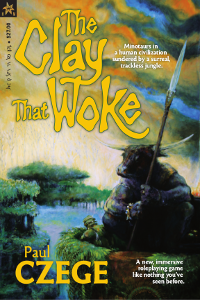I started to feel that I didn’t know roleplaying games well enough so I came up with the plan to read a roleplaying game corebook for every year they have been published. Selection criteria is whatever I find interesting.

It’s rare to see a properly realized, rich setting in an indie game. The Clay That Woke feels like it seeks to combine the mechanical acuity of indie design with an intricate, non-obvious approach to setting design. The result is magnificent, a wonderful, unique and nuanced game.
One of the problems of improvised co-creation is that often people’s first ideas (mine included) are obvious. If we are asked to improvise a setting, it becomes a collection of genre clichés. This is why I love it when someone has really worked through how to make a unique setting, something that goes beyond the usual well-worn elements.
The player characters are minotaurs, a menial class of people living in the grand city of Dégringolade. They’re always male, according to legend born from four minotaur infants lifted from the river mud. To keep themselves together, they try to adhere to a social code called Silence. If they break the Silence, they lose themselves and run to the jungle surrounding the city. There they experience strange dangers and eventually find what they need to come back to their old occupations.
No minotaur starts with a name. Through their actions they may acquire one.
In my reading, the minotaurs feel like a metaphor for the masses of futureless young men found in many countries with a lack of opportunities. However, the setting doesn’t empty into any single meaning or interpretation. It’s too rich for that.
The Clay That Woke uses an interesting resolution mechanic. The players and the GM have tokens they cast into the Krater, a cup. The player takes four tokens at random and the combination they make explains what happens. It’s a cool aesthetic choice, making task resolution feel almost like a small ritual of divination. Which it of course is!
Visually, The Clay That Woke is a real treat. In addition to the use of fiction in the text, there are also beautiful and intricate illustrations aplenty, with a distinct art style bringing into mind the serious worldbuilding of science fiction before we all became too self-aware to really believe.